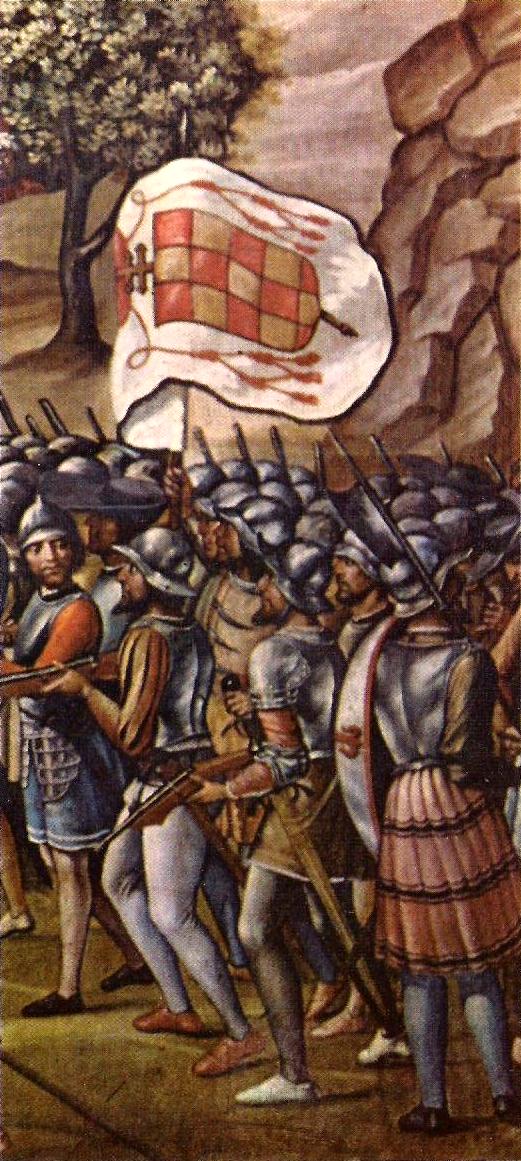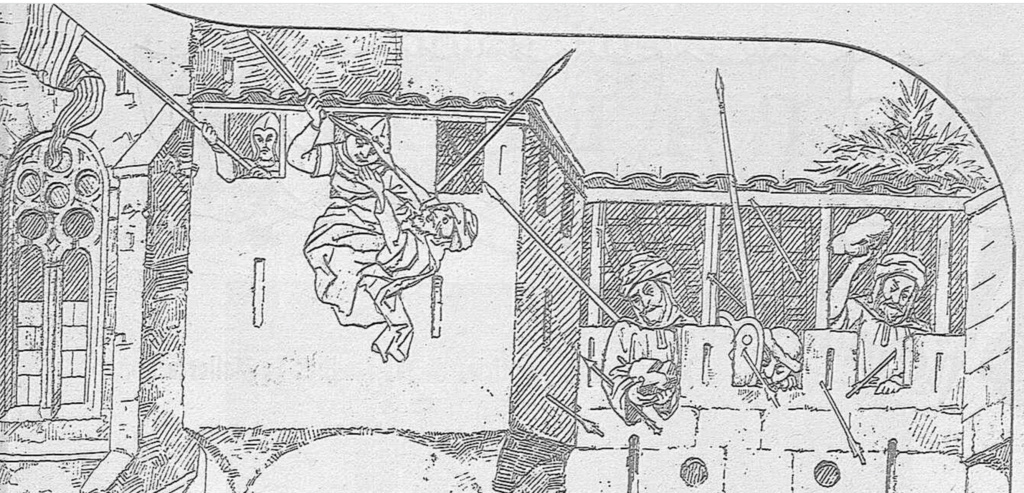
| myArmoury.com is now completely member-supported. Please contribute to our efforts with a donation. Your donations will go towards updating our site, modernizing it, and keeping it viable long-term.
Last 10 Donors: Anonymous, Daniel Sullivan, Chad Arnow, Jonathan Dean, M. Oroszlany, Sam Arwas, Barry C. Hutchins, Dan Kary, Oskar Gessler, Dave Tonge (View All Donors) |
| Author |
Message |
Pedro Paulo Gaião

|
 Posted: Thu 24 Sep, 2020 6:17 am Post subject: Historical "Shortsword"? Terçado in Portuguese Chr Posted: Thu 24 Sep, 2020 6:17 am Post subject: Historical "Shortsword"? Terçado in Portuguese Chr |
 |
|
I'm reading an academic work called "Dressed to Kill", by Paulo Jorge Simões Agostinho which deals with 15th-century military sources for references of arms and armor in Portuguese Chronicles. Eventually, I came across some written references for a "Terçado". My notes are in parenthesis
| Quote: | | "The fourth type of sword found in the chronicles was the Terçado. It refers to a sword, shorter and lighter than the 'belt-sword' (medieval Portuguese name for an arming sword). It's was equivalent to two-thirds of a sword, thus given its name [...]. This weapon is referred only to events in North Africa (starting by 1415/1420), of which indicates a relatively recent sword. Perhaps, African context might have led to a greater search for lighter weapons. " |
My question is: can a Terçado be related to any existing shorter sword in Europe? Could it be a Cinquedea? Other European regions actually gave a name for a "two-thirds" sword? I hardly think Terçado means a Falchion, as we have evidence for their use in the Peninsula long before the 15th century.
“Burn old wood, read old books, drink old wines, have old friends.”
Alfonso X, King of Castile (1221-84)
|
|
  |
 |
|
Pieter B.
|
 Posted: Thu 24 Sep, 2020 7:04 am Post subject: Posted: Thu 24 Sep, 2020 7:04 am Post subject: |
 |
|
You might find this old thread on another site interesting.
http://www.vikingsword.com/vb/showthread.php?...&pp=30
Essentially it seems like we're looking at a sword that is 'a third' shorter than normal swords. A lot of Central European messer's have a blade round about 60 centimeters in length and some have a somewhat curved tip.
Quite a bit of 15th century art made in the Low Countries such as tapestries and paintings, some of them ordered by Portuguese, tend to show the Moors with short swords that often have a knucklebow. Some later 16th century indigenous works also show such weapons.
For example the Capture of Oran shows both normal swords and shorter ones.





|
|
  |
 |
Paul Hansen

|
|
  |
 |
|
Jeff Cierniak
Location: NE United States Joined: 17 Sep 2020
Posts: 79
|
 Posted: Wed 14 Oct, 2020 4:27 pm Post subject: Posted: Wed 14 Oct, 2020 4:27 pm Post subject: |
 |
|
|
Nimcha is possible I suppose, but some depictions (as one above) show straight, shortish, presumably two sided blades with knuckle bows. I find it pretty interesting as I haven't personally seen historical examples.
|
|
   |
 |
Pedro Paulo Gaião

|
 Posted: Sat 15 Apr, 2023 1:38 pm Post subject: Posted: Sat 15 Apr, 2023 1:38 pm Post subject: |
 |
|
Just noticed it has been 3 whole years. But good news, I SOLVED IT.
I recently realized this sword was of North African rather than Portuguese/European invention because it's mentioned in numbers among the loot taken by the Portuguese which included other Morrocan arms such as adargas. Just to remember: the Terçado only appears in 15th century sources about African campaigns ...
So, I was looking at the etchings made by Pedro Nissart for a church in Palma, Mallorca (Kingdom of Mallorca, part of the Crown of Aragon, conquered by Christians from the Muslims in the 13th century) made at 1468-70, as I was searching for Balearic Islands or Aragonese armor. And one of the Muslim defenders uses a shortsword, straight. This dismisses the possibility that the Terçado could be curved (in fact many modern sabers are called terçado in the Portuguese language).

https://upload.wikimedia.org/wikipedia/commons/4/4c/La_Roqueta_-_Entrada_del_Rey_en_Jaume_a_la_ciutat_de_Mallorca.jpg?fbclid=IwAR0Rm0v2HaaGXGuF6HLX-CroM5z1lwFi99mPsu8P33PCsnz-Y_B0OxZIweg
Nissart depicted very well the arms of soldiers in the main St. George pannel, and while I would argue the plate armor is made in Flemish style (many disagreed, but ok), the weapons are fine. Especially the muslim ones.
“Burn old wood, read old books, drink old wines, have old friends.”
Alfonso X, King of Castile (1221-84)
|
|
  |
 |
Iagoba Ferreira

|
|
  |
 |
Pedro Paulo Gaião

|
 Posted: Sun 18 Jun, 2023 9:12 pm Post subject: Posted: Sun 18 Jun, 2023 9:12 pm Post subject: |
 |
|
Knowing the Spanish name helped me to find a Spanish page that posted an extant terciado dated 1570-1590, the photo speaks for itself:

They didn't give dimmension or where the sword is, butI tried to use paint to guess how wide the blade is at the base, using the pommel as reference (supposing a 5cm diameter). It's around 8cm (below the finger-cut); I don't trust on my measures of the blade, but it gave some 16 pommels, or 80cm blade long.
These were probably 16th century European developments over the African Terçado, as the example in the Palma's Cathedral is obviously slimmer, while another 16th century Tercio engraving, showing sword-and-shield armoured foot, shows wide terciados and wide alfanges (sabers):
https://www.facebook.com/photo?fbid=125848330335479&set=pcb.125850550335257
“Burn old wood, read old books, drink old wines, have old friends.”
Alfonso X, King of Castile (1221-84)
|
|
  |
 |
|
|
You cannot post new topics in this forum
You cannot reply to topics in this forum
You cannot edit your posts in this forum
You cannot delete your posts in this forum
You cannot vote in polls in this forum
You cannot attach files in this forum
You can download files in this forum
|
All contents © Copyright 2003-2024 myArmoury.com — All rights reserved
Discussion forums powered by phpBB © The phpBB Group
Switch to the Basic Low-bandwidth Version of the forum
|

